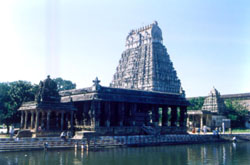|
 Kanchipuram is a small, rural town about 75-km from Chennai in the state of Tamil Nadu. With the Sankara Mutt acting as the hub of Hindu activities and the temples, Kanchipuram is one of the most highly visited pilgrimage spots in India, and can rightfully be called the " Religious Capital of South India". Kanchipuram is a small, rural town about 75-km from Chennai in the state of Tamil Nadu. With the Sankara Mutt acting as the hub of Hindu activities and the temples, Kanchipuram is one of the most highly visited pilgrimage spots in India, and can rightfully be called the " Religious Capital of South India".
Kanchipuram was under the Pallavas from the 6th to 8th century AD and later became the citadel of the Cholas, Vijayanagar Kings, the Muslim and the British. It has been a center of Tamil learning, cultural and religious background for centuries. Kanchipuram has magnificent temples of unique architectural beauty bearing eloquent testimony to its glorious Dravidian heritage.
All the religious cities in India support one of the two sects in Hinduism - Vaishnavism and Shaivism, but Kanchipuram has blended itself equally to both the sects, dividing itself into Vishnu Kanchi, surrounding the Varadaraja Temple, and Shiva Kanchi, surrounding the Ekambareshwar (also spelt as Ekambareshwa) Temple, while the Kamakshi Amman Temple stands in between as a place of Shakti worship.
Kamakshi Amman Temple
India has three main cities where the Goddess Shakti is worshipped. Kanchipuram holds the most important rank among the three. In the same order, the three places are Kanchipuram, where the Goddess Kamakshi is worshipped, Madurai, where the Goddess Meenakshi is worshipped, and Kashi, where the deity is 'Visaalakshi'.
The Kamakshi Amman temple is the hub of all religious activities in Kanchipuram. The temple is also in closer control of the Shankara Mutt, unlike the other temples, which are governed either by the Department of Archeology, Government of India, or the Hindu Temples Department of the Tamil Nadu Government. The kings of the Chola Empire built the temple in 14th century AD.
The main tower over the sanctum (Vimanam) of the temple is gold plated. Also of significance is the Golden Chariot in this temple. The Golden Chariot is taken in a procession around the temple on Friday evenings around 7.00 p.m. This temple also features an Art Gallery with pictures depicting the history of Sri Adishankaracharya and the Shankara Mutt.
Kailashanathar Temple
Dedicated to Lord Shiva, Kailashanathar (also spelt as Kailashnatha) is one of the earliest temples built by the Pallava ruler Rajasimha Pallava and was completed by his son, Mahendra Varma Pallava in the 8th century AD. It is the oldest structure in Kanchipuram and the finest example of Pallava architecture in South India. The temple is situated among several low-roofed houses just over 1-km west of the town center.
Of all the temples in India, no other edifice has been so elaborately filled with all the 64 aspects of Lord Shiva. The temple is unique in its architecture and is viewed more as an architectural wonder than as a holy place. Hence, it is never crowded with locals. But, once in a year during Shivaratri festival large crowds visit the temple and there could be hours of waiting in long queues.
Ekambareshwar Temple
Ekambareshwar temple dedicated to Lord Shiva, is one of the largest temples in Kanchipuram, spreading over an area of 12.14 hectares. This ancient temple is surrounded by a huge stonewall built in the early 16th century during the days of the Vijayanagar Empire.
Ekambareshwar temple is of hoary antiquity, beginning as a small fane, it has grown over the centuries into a large one with innumerable shrines, Mandapams, Gopurams and Tanks. It is considered to be one of the most ancient temples in India and has been in existence even prior to 600 AD. It enshrines many traditions.
Kumara Kottam
Kumara Kottam is located in between the Kamakshi and Ekambareshwar temples in the Somaskanda formation in the town of Kanchipuram. It is a well-visited temple with two Prakarams and a complete pantheon of Parivara Devatas enshrined in their respective shrines.
In the sanctum, Muruga is in a seated pose. Valli, Deivayani are absent here, but their festival idols are kept here. In accordance with the function of Creation he has assumed, his right arm is in Abaya pose, the upper hand holds the rosary, and the lower left arm is on the thigh in Katyavailambita pose with the left arm holding the Kamandalam. The posture is also called "Brahma Chattam".
Here only honey is used for ablutions. When one comes out after worshipping the main deity, one can see the festival idols. In the front part of the temple in the mirror room one can see the marble figure of Ramalinga Swamigal.
Varadaraja Temple
The Varadaraja temple is one of the important shrines of Sri Vaishnavites, also known as "Hastigiri" and is one of the celebrated Vaishnava Divya Desams, located in Vishnu Kanchi or "the Little Kanchi". Originally it was known as "Attiyuran". The main deity here is Varadaraja Perumal in a standing posture facing west and the Lord here is also known as "Devaraja", "Pranatharthihara", "Deva Perumal", "Athiyooran" and "Perarulalan".
Varadaraja temple with superb art has a magnificent history, which is associated with Sri Ramanuja, who used to serve here. Many miracles are said to have occurred. It was with his ministry that the temple, then already several centuries old, began to gain fame.
Ulahalanda Perumal Temple
Ulahalanda Perumal temple, situated about half a kilometre from the centre of the town near Kamakshi Amman temple is one of the oldest temples in Kanchipuram. The deity Ulahalanda Perumal in this temple represents the "Vamana Roopam", an incarnation of Lord Vishnu taken to save the Devas from the Demon king Mahabali. The deity Ulahalanda Perumal is depicted by a huge image of about 35 feet high. |